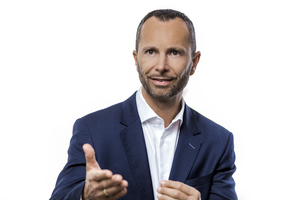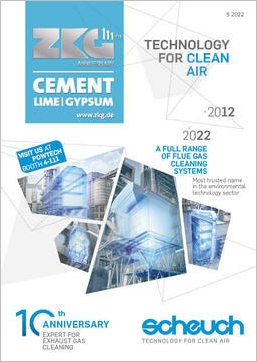The election of Thomas Perterer as the new chairman of the BVK enabled Dr. Petra Strunk, Editor-in-Chief of ZKG Cement Lime Gypsum, to put to the new chairman a number of questions on the lime industry in difficult times, on the upcoming tasks of the BVK and on planned projects to prepare the lime industry for future challenges.
Mr Perterer, congratulations on your election to the chairmanship on the BVK. You take over this office in difficult times: the Corona statistics, the war in Ukraine and new reports on climate change are the dominant topics in the news. How great are the effects of these factors on the German lime industry and how can the association support individual companies?
Thank you for your congratulations, and you are right, of course, the boundary conditions for the lime industry have rarely been more challenging than they are today. The continuing consequences of the Corona crisis and the war in Ukraine certainly have significant effects on the overall dynamics of the economy, and those effects will, logically enough, also not pass our industry by without trace. Nonetheless, we managed in the first six months to achieve almost the level of 2019 in sales volumes on the core markets of our member companies. On the other hand, expectations for the second six months of the year, with the continuation of the Ukraine crisis, are increasingly clouded and a substantiated prediction for 2023 is currently virtually impossible, in view of the imponderables in energy supplies and the unforeseeable consequences of further waves of Corona. Those, however, are only the short-term challenges that demand a great deal of attention at the present time. The mid- and long-term targets concerning climate-neutral production remain for companies of the lime industry – irrespective of the climate debate currently being displaced from the headlines – indisputably the most important and, at the same time, the most difficult to achieve.
We as an association are therefore doubly challenged: on the one hand, only very few are aware of how diverse the value chains are and that they can very rapidly break down without our products - as a result, for example, of shortages in supply of gas and electricity to our plants. Here, we have been able to achieve an important success: the lime industry is one of the sectors listed in the advisory decision-making document of the EU Commission’s Emergency Gas Plan which are to continue to be supplied with gas as a priority should a gas shortage occur. We, as an association, must establish even more firmly in all political and non-political circles this understanding of the relevance of our products for the functioning of the basic supply of drinking water, electricity and food, as well as the maintenance of the critical industrial production of steel and of basic chemicals.
On the other hand – and here we still have a significantly more difficult path before us – we must, against this background of system relevance, put the topic of CO2 management in our industry significantly more emphatically in focus. Our aim must be to sharpen the awareness of those politically responsible to the fact that our industry produces indispensable basic resources and, simultaneously, provides a great lever for the effective avoidance of large quantities of CO2. And it is precisely here that the BVK intends to position itself even more clearly in the coming years.
Scarcity of resources is an unending topic at present. How do you estimate the trend in the need for the resource “lime” in the nearer future? What tasks will attach to the BVK in the control of the market?
If one examines the currently much quoted lead studies on possible decarbonisation scenarios of industry in Germany, it can be derived that the need for burnt lime will remain stable over the coming decades, or will, possibly, decline slightly. This is the reason, above all, for the following assumptions for the national and European markets: in the long term, high production levels for iron and steel, growing demand for building resources and a long-term loyalty to the locations of the chemicals industry, on the basis of rising needs for residential building and significant investments in infrastructure. In view of geopolitical developments and the resultant critically greater risks of inadequate assuredness of supply of primary energy, and, also, primary resources – including, above all, non-ferrous metals and rare earths – Germany should tailor its resources strategy toward reducing dependency on imports to as few sectors as possible.
We have significant limestone deposits in Germany. A clear home-game advantage, one might think. But in reality, resources-recovering and processing industries have a difficult existence in this country. The “not in my backyard” philosophy and the generally declining acceptance of industry in broad groups of the population in highly developed, democratic countries makes accessing of existing and recoverable resources ever more complex, ever more costly and ever more controversial. Increasingly escalating requirements in approval law, the insufficient availability of renewable sources of energy, exponentially rising prices for emissions certificates and ever more difficult to find potentials for the necessary restoration measures complicate the situation even more. But for the targeted CO2 transformation of industry, industry itself must also be in a position to do its job. We must create today the financial preconditions and also an economically viable perspective in order to be able to achieve the path to climate-neutral lime production.
We met the trends of recent years with the founding of our office in Berlin. We have arrived in our capital city’s political life and are now well networked. As an association, we offer extremely good arguments in favour of “Lime – Made in Germany”, which we must now make comprehensible to the political decision-makers. The resources for our broad and – as already mentioned – very largely system-critical product portfolio is literally at our feet. And we can recover and process it – ideally, climate-neutrally in future – while adhering to extremely high quality standards and demands at local level for the conservation of species, the environment and nature. But active climate protection also demands active protection for those who are courageous enough to make, even now, the first significant investments in CO2 removal and thus – with existential financial efforts – to play a pioneering role. These private entrepreneurial risks can be taken on responsibly for our highly fragmented commodity business only if it is assured that the legal boundary conditions for CO2 management exist and that smart mechanisms, such as climate-protection contracts and carbon border adjustment mechanisms, have been established on their basis. These are our minimum demands. Because only in this way can a starting position be created in order to place these transformation paths on solid foundations and permanently exclude carbon leakage.
The BVK has passed the Lime Industry 2045 roadmap, which formulates climate-neutral lime production as a vision by 2050. The occurrence of CO2 is unavoidable in the process for the production of calcined lime. The BVK is already working on projects with research institutions on ways to remove and further process this CO2; a living lab in the Harz region is planned. Could this route also be interesting to other branches of industry and are there already cooperative contacts and projects of the BVK with industry in order to master the challenges of CO2-neutral production together with other industries in the future?
The companies involved in the BVK subscribe without exception to climate-protection targets and take the upcoming challenges for the attainment of these targets extremely seriously. This is why we passed the roadmap last year as a joint vision. The fact that we must even now revise it in the upcoming months, in order to bring our ambitions into harmony with the European Union’s submissions of target specifications for 2045 for the achievement of climate neutrality, simply demonstrates how dynamic the ongoing discussion is.
To eliminate the erratic from this dynamic, we, the BVK, shall be working even more intensively in the coming months, in close coordination with EuLA, the European Lime Association, on structuring the narrative of our roadmap even more clearly. We will define the terms used uniformly and unambiguously, explain the bases of unavoidable, process-induced CO2 emissions more comprehensibly and describe more clearly the technical possibilities and limitations currently existing for comprehensive CO2 management. Once this has been completed, we will have an even sharper sword to perform our core function as an association with even more emphasis then previously: making a decisive contribution to ensuring that our member companies find before them the indispensable legal and socio-political boundary conditions and thus a “level playing field”, for the taking of sustainable entrepreneurial decisions. The demands made on the BVK have never been greater, and it has never been more important, as a company, to energetically support the BVK in this role. But one thing must be clear, however: as a relatively small association, we do not yet have the recognition in Berlin to directly command attention at any time and from the relevant body for our concerns. For this reason, it is a personal priority of mine to significantly expand cooperation with associations that represent interests similar to our own. The VDZ (cement) and VIK (energy), in particular, are well established “sparring partners” in this respect.
The reorientation of the BVK during the strategy process completed in the course of 2020 also resulted in a shift in the emphases of the association’s internal research: less product and application technology, and instead more emphasis on initiatives for measures for CO2 reduction in lime production. From this also developed, among other things, the cooperation with Prof. Eckehard Specht’s institute at the University of Magdeburg for the scaling up of a CO2 removal technology from laboratory to living lab scale. Here, the BVK played an important role as a facilitator: The planned founding of the living lab consortium, mentioned for further development of a new separation technology not yet tested on a commercial scale, is a project in which the member companies can participate. Here, another thing becomes clear: the solutions that will finally be successful and become established will, ultimately, be decided by the market.
Finally, a rather more personal question: During your upcoming period in office, as newly elected chairman of the BVK, what is your special concern and interest, and what tasks and projects would you like to further?
The BVK is a technically highly competent and highly respected association. I would like my role as chairman during the two upcoming years, jointly with Martin Ogilvie, as the face and voice of the BVK, to be to more clearly present our external image and our external effects. It is of great importance to set the right paths in communications terms: On the road to a climate-neutral Germany, the lime industry must be regarded not as part of the problem, but rather as part of the solution. We make products that are indispensable for innumerable value chains. At the same time, we are aware of our ecological footprint and are working on sustainable technological changes. We are prepared to go the steps necessary to meet the 1.5 degree target of the Paris Climate Agreement and demand for this nothing more – but also nothing less – than a clear political commitment to the retention of the lime industry in Germany and corresponding legal and socio-political boundary conditions. It is our task to implant this narrative firmly in the minds of the political decision-makers.


